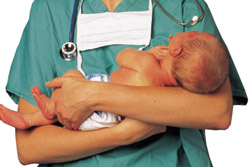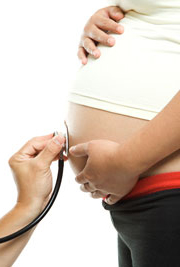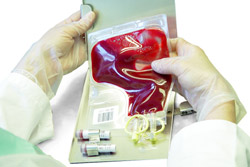- What is Postpartum Haemorrhage (PPH)
- Statistics on Postpartum Haemorrhage (PPH)
- Risk Factors for Postpartum Haemorrhage (PPH)
- Progression of Postpartum Haemorrhage (PPH)
- Symptoms of Postpartum Haemorrhage (PPH)
- Clinical Examination of Postpartum Haemorrhage (PPH)
- How is Postpartum Haemorrhage (PPH) Diagnosed?
- Prognosis of Postpartum Haemorrhage (PPH)
- How is Postpartum Haemorrhage (PPH) Treated?
- Postpartum Haemorrhage (PPH) References
What is Postpartum Haemorrhage (PPH)

The site of blood loss varies depending on the cause of the bleeding.
The causes of primary postpartum haemorrhage include:
- Uterine atony – which is the failure of the uterus to contract down following delivery of the placenta. This allows the blood vessels feeding into the site where the placenta was attached to continue to bleed. This is the most common cause of primary postpartum haemorrhage.
- Trauma – trauma sustained during delivery can lead to considerable blood loss. Sites of injury may include an episiotomy, the vulva, vagina and/or cervix, a ruptured uterus and other rarer causes.
- Retained placenta – if part, or all, of the placenta remains in the uterus, it prevents the normal process of contraction and as a result the blood vessels feeding into the site where the placenta was attached continue to bleed. There is no correlation between the amount of tissue retained and the amount of blood lost.
- Blood clotting abnormalities- in rare cases women may have an inherited bleeding disorder such as haemophilia or von Willebrand disease that can lead to excessive bleeding following childbirth. Other complications during pregnancy including preeclampsia, fetal death in utero, severe infection, amniotic fluid embolus and placental abruption can lead to problems with blood clotting.
The cause of a secondary postpartum haemorrhage is unclear in approximately one third of women. The most common causes include failure of the uterus to contract down normally, retained placenta and infection.
Statistics on Postpartum Haemorrhage (PPH)
Postpartum haemorrhage occurs in 10.5% of women with live births.
Secondary postpartum haemorrhage affects approximately 1% of women following childbirth.
Risk Factors for Postpartum Haemorrhage (PPH)

- Uterine over-distension;
- Having greater than five pregnancies over 20 weeks gestation;
- Previous postpartum haemorrhage;
- Vaginal bleeding during the pregnancy or labour;
- Previous retained placenta;
- Anaemia;
- Rapid or incoordinate labour;
- Prolonged labour;
- Induction of labour;
- Obesity;
- Asian ethnicity;
- Caesarean section delivery;
- Fever during labour;
- Age >40;
- Placental abruption;
- Placenta praevia;
- Chorioamnionitis;
- Genital tract trauma;
- Stillbirths;
- Epidural anaesthesia;
- Maternal bleeding disorders;
- Condition of high blood pressure including preeclampsia and gestational hypertension; and
- The use of certain drugs during pregnancy.
Those at greater risk of a secondary postpartum haemorrhage include:
- Women with primary postpartum haemorrhage – 7 times greater risk; and
- Women who underwent manual removal of a retained placenta – 4 times greater risk.
Symptoms of Postpartum Haemorrhage (PPH)
Post partum haemorrhage affects different women in different ways depending on:
- The amount of blood lost;
- The availablitly of treatments, including blood transfusions; and
- The health condition of the woman prior to and during the pregnancy.
If the bleeding occurs in the first 24 hours following delivery (primary postpartum haemorrhage) it is likely that the abnormal blood loss will be picked up by the midwifery staff or obstetrician caring for you. However, if the excessive blood loss is occurs following the first 24 hours after delivery (secondary postpartum haemorrhage) you yourself may notice the increased blood loss as increased need for sanitary napkin changes and/or increased loss into the toilet/shower.
Depending on the amount of blood loss, you may experience some of the symptoms of anaemia including tiredness and lethargy. The amount of blood loss may be so severe that you may require a blood transfusion. You may even need to undergo other treatments including surgery (discussed below) to help prevent further blood loss.
You may experience difficulty breastfeeding your baby if your pituitary gland has been affected by the blood loss as well as other symptoms of Sheehan’s syndrome, discussed above.
Clinical Examination of Postpartum Haemorrhage (PPH)

Questions regarding the pregnancy, labour and delivery may be asked to assess for risk factors which may help to identify the cause of bleeding.
While managing the blood loss, several key examinations need to be performed in an attempt to identify the cause and control the haemorrhage. These include:
- Examination of uterine size;
- Examination of the placenta for completeness; and
- Examination of the birth canal for trauma .
How is Postpartum Haemorrhage (PPH) Diagnosed?
Postpartum haemorrhage is diagnosed clinically when significant blood loss (>500mL) is observed.
Prognosis of Postpartum Haemorrhage (PPH)

- Amount of blood loss;
- Health of the mother prior to the event; and
- Treatment availability including blood transfusions.
Significant postpartum haemorrhage may be associated with the development of Sheehan’s syndrome, severe anaemia and maternal mortality.
Sheehan’s syndrome
In postpartum haemorrhage, massive blood loss can reduce the supply of blood to the pituitary gland and cause cell death. If greater than 10% of the gland is affected, then the woman can be affected by symptoms of anterior pituitary insufficiency including:
- Failure to lactate (breastfeed);
- Weakness;
- Lethargy;
- Hypersensitivity to cold;
- Decreased sweating;
- Atrophy (shrinking) of the external genitalia;
- Amenorrhea (loss of periods) or oligomenorrhea (reduced periods);
- Hair loss; and
- Absences of menopausal symptoms.
Anaemia

Maternal mortality
The incidence of maternal death in Australia is very low (approximately one death for every 10,000 deliveries) compared to other parts of the world. For example the rate of maternal death in Sub-Saharan African women is over 100 times greater. Postpartum haemorrhage remains a significant cause of maternal death worldwide and is responsible for 17% of all maternal deaths in developed countries such as Australia.
How is Postpartum Haemorrhage (PPH) Treated?

- Antenatally, each women should know their blood group;
- Anaemia during pregnancy should be treated;
- Prolonged inhalatory pain relief should be avoided;
- Squeezing or kneading of the uterus prior to separation of the placenta should be avoided;
- The placenta should be delivered promptly following separation; and
- The woman should remain in the delivery room for at least one hour post delivery with careful observations made.
In high risk women additional precautions may need to be taken including several blood tests and the insertion of an intravenous cannula. An intramuscular injection of syntometrine may be given following delivery of the foetus to assist with delivery of the placenta.
Active management of primary postpartum haemorrhage

- Calling for help;
- Massaging the uterus (done by a health professional);
- Measuring/estimating blood loss as soon as possible;
- Monitoring of vital signs (temperature, blood pressure, pulse and breathing); and
- Alerting senior obstetrics and anaesthetic doctors.
While this occurs, the doctors will be considering the likely cause of the bleeding. They may need to inspect the placenta for completeness and the genital tract for any trauma or lacerations. If an intravenous cannula is not already in place, one and possibly two will be inserted for the rapid delivery of fluids. Blood will be taken and the availability of blood for a blood transfusion determined. You may be given an intramuscular injection to help aid contraction of the uterus. A urinary catheter may also be inserted.
If an episiotomy or other trauma is the suspected cause of the bleeding, then this will be repaired as soon as possible.
If uterine atony is the suspected cause, the doctors will attempt to compress the uterus, which involves placing one hand on the abdomen and the other inside the vagina. Additional medication may be used to help the uterus contract.
If the bleeding is greater than 1 litre, the bleeding does not stop or if the cause is not obvious you will be transferred to theatre.
In theatre, compression of the uterus can be continued and an inspection of the birth canal made under an anaesthetic. You may be given fluids and substitutes to help replace the lost blood. Antibiotics may be given. The doctors may also decide on giving an injection directly into the uterus to aid contraction of the uterus.
If these measures prove to be ineffective other modalities of treatment include:
- Uterine / vaginal tamponade – where a balloon like device is inserted into the uterus and filled with fluid until it expands and exerts pressure on the wall of the uterus.
- Aortic tamponade – The use of pressure through the abdominal wall to compress the aorta against the spine may slow the rate of blood loss.
Surgical therapies
B-lynch suture – this method aims to exert continuous vertical compression by way of a suture that runs the full thickness of both the anterior and posterior uterine walls.
- Uterine artery ligation – the uterine arteries are the major source of blood to the uterus and hence the ligation (tying off) of these arteries is a method of controlling postpartum haemorrhage. The uterus remains viable due to blood feeding into it from smaller vessels. Subsequent menstruation and pregnancies are unaffected by this procedure.
- Internal iliac artery ligation – this can also be performed in an attempt to control postpartum haemorrhage or in any situation associated with uncontrolled pelvic bleeding. Care must be taken to positively identify both the external and internal branches of the iliac artery as ligation of the external iliac artery may result in loss of the lower limb. Care must also be taken to avoid the ureter, which lies close by.
- Hysterectomy – is an effective and often lifesaving procedure where the bleeding cannot be controlled by other methods. However, deaths do occur following and during hysterectomy in cases of massive haemorrhage and where the procedure is delayed until the patient is nearly moribund.
Non-surgical therapies
- Selective pelvic arterial embolisation – performed using radiologic guidance, this involves the insertion of a catheter through an artery in the leg, and is then fed through to the arteries supplying the uterus to occlude them. This procedure takes less than two hours.
- Recombinant factor VIIA (Novoseven) – is an artificial clotting factor. Its effectiveness as a primary therapy in the treatment of postpartum haemorrhage is still being investigated, however, several case reports suggest that the use of recombinant factor VIIA is effective in treating ongoing bleeding in massively transfused patients. Its use requires consultation with at least two hospital consultants which should include an obstetrician/surgeon, anaesthetist and/or haematologist.
Management of secondary postpartum haemorrhage

If the woman is shocked or there is significant ongoing blood loss an emergency code is called for prompt resuscitation. The women should be transferred to theatre where an examination under anaesthetic can take place. Two intravenous cannulae are inserted with bloods samples taken. Intravenous antibiotics are initiated along with medications to aid contraction of the uterus. Bimanual compression of the uterus may be required if the ongoing blood loss is severe.
If the woman is stable, an intravenous cannula will still need to be inserted with a blood sample taken. The size of the uterus is assessed and the cervix examined. Examination of the cervix involves insertion of a speculum into the vagina, a similar process as involved in a pap smear.
All women with a secondary postpartum haemorrhage following a caesarean section will be admitted to hospital due to the risk of significant continued bleeding from infection and other causes.
Clinical examination will elucidate the cause, which can then be treated as appropriate. In many cases, initial treatment involves the use of antibiotics to control infection. If blood loss has not settled 24 hours post antibiotic therapy, then examination under anaesthetic is considered.
Selective pelvic arterial embolisation is considered for women with ongoing significant blood loss, especially if the woman has had a previous caesarean section.
Where the woman continues to bleed following examination under anaesthetic, other options include uterine tamponade, use of recombinant factors, laparotomy with ligation of uterine vessels or hysterectomy as for management of a primary postpartum haemorrhage.
More information
 |
For more information about pregnancy, including preconception advice, stages of pregnancy, investigations, complications, living with pregnancy and birth, see Pregnancy. |
Postpartum Haemorrhage (PPH) References
- World Health Organisation. 2007. Managing complications of pregnancy and childbirth: a guide for midwives and doctors. Geneva. Available from: < http://whqlibdoc.who.int/publications/2007/9241545879_eng.pdf> [cited 4 March 2010].
- KEMH clinical guidelines B 9.1.1 Primary postpartum haemorrhage. June 2009. Available from: < http://www.wnhs.health.wa.gov.au/development/manuals/O&G_guidelines/sectionb/9/b9.1.1.pdf> [cited 21 February 2010].
- KEMH clinical guidelines B 9.1.4 Secondary postpartum haemorrhage. September 2006. Available from: < http://www.wnhs.health.wa.gov.au/development/manuals/O&G_guidelines/sectionb/9/b9.1.4.pdf> [cited 21 February 2010].
- Oxorn H. 1986. Human labor and birth. 5th ed. Appleton Century Crofts, Norwalk, Connecticut. pp 479-97.
- Dolea C, AbouZahr C, Stein C. Global burden of maternal haemorrhage in the year 2000. Evidence and Information for Policy, World Health Organisation, Geneva, 2003. Available from: < http://www.who.int/healthinfo/statistics/bod_maternalhaemorrhage.pdf> [cited 4 March 2010].
- CEMACH. 2004. Why Mothers Die: Report on Confidential Enquiries into Maternal Deaths in the United Kingdom 2002- 2004. Triennial Report London: RCOG Press. pp 94-103.
- El-Hamamy E, Wright A, B-Lynch C. The B-Lynch suture technique for postpartum haemorrhage: a decade of experience and outcome. Journal of Obstetrics and Gynaecology 2009; 29: 278-83.
- B-Lynch C, Coker A, Lawal AH, Abu J, Cowen MJ. 1997. The B-Lynch surgical technique for control of massive post partum haemorrhage: an alternative to hysterectomy? Five cases reported. British Journal of Obstetrics and Gynaecology 104: 372-6.
- Elhassan EM, Mirghani OA, Adam I. The B-Lynch surgical technique for control of postpartum haemorrhage. Journal of Obstetrics and Gynaecology 2010; 30: 94.
- Magann EF, Evans S, Hutchinson M, Collins R, Howard BC, Morrison JC. Postpartum Hemorrhage after vaginal birth: an analysis of risk factors. Southern Medical Journal 2005; 98: 419-422.
All content and media on the HealthEngine Blog is created and published online for informational purposes only. It is not intended to be a substitute for professional medical advice and should not be relied on as health or personal advice. Always seek the guidance of your doctor or other qualified health professional with any questions you may have regarding your health or a medical condition. Never disregard the advice of a medical professional, or delay in seeking it because of something you have read on this Website. If you think you may have a medical emergency, call your doctor, go to the nearest hospital emergency department, or call the emergency services immediately.








